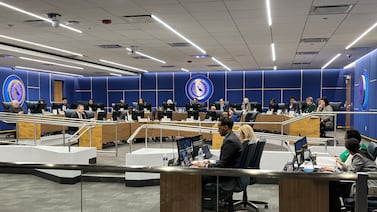The Detroit school district is employing some new methods in its fight to improve attendance, including paying students up to $1,000 each for perfect attendance and holding back students with extremely high rates of chronic absenteeism.
The new initiatives will add to work the district has had in place for years, much of it centering around attendance agents whose job is to improve attendance, connect with families of absent students, and provide resources families need to prevent absenteeism. That work has led to decreases in the rate of chronic absenteeism.
Incentives and negative consequences for repeated absences aren’t particularly new, though there is mixed research about their effectiveness and some experts worry that they potentially ignore the often insurmountable at-home challenges, much of it related to poverty, that prevents students from coming to school regularly.
Students are considered chronically absent in Michigan if they miss 10%, or 18 days, in a typical 180-day school year. In the Detroit Public Schools Community District, 66% of students were chronically absent in the 2023-24 school year, down from nearly 80% at the height of the pandemic in the 2021-22 school year.
The still high rates impact efforts to improve academic performance in the district, leaves absent students far behind, and affects learning for all students.
Here is what the district is doing:
- The district launched “Perfect Attendance Pays” this month, allowing high school students to receive a $200 gift card for each two-week period in which they have perfect attendance. The first two-week period began Monday and runs through Jan. 17. The final two-week period runs from March 10-21. Students who have perfect attendance in each of the five periods will earn up to $1,000 in gift cards. Students must be in class for every hour of the day in order to have perfect attendance. Detroit one million first reported on the incentives in December.
- The district previously announced a new grade promotion policy. Students in grades K-8 who miss 45 or more days over the course of the school year may be required to repeat the grade. High school students who miss 23 or more days of a single course in a semester will need to retake the course or enroll in credit recovery.
Schools for years have provided incentives throughout the year to promote attendance, particularly on the two important days in the year when student enrollment counts are used to determine how much state aid districts will receive. In the Oakland Unified school district in California, students who were severely chronically absent were paid $50 each Friday if they attended school each day that week. That program differs from what Detroit is doing because it was targeted only at students who were struggling to attend school.
Also, state law allows students who are persistently absent from school to face penalties through the county court system. Parents also can face charges, and those who receive public assistance can have that money revoked if their children aren’t attending school.
In both instances, the district cited the need to improve attendance as part of the reasoning for the two initiatives.
“Consistent attendance is an essential part of students’ success and we know that when District students miss less than 18 days of school in our District, they are 3 to 5 times more likely to be at and above grade level in reading and math and to be college ready as defined by the SAT,” Superintendent Nikolai Vitti said in a letter to families.
Angelique Peterson-Mayberry, president of the Detroit school board, told the audience at a December meeting that students who end up being held back won’t be surprised because they will be communicated with throughout the process about their risk.
“This is not meant to be punitive. However, we are trying to foster accountability and enforce a set of excellence and standards with our young scholars,” Peterson-Mayberry said. “We know that there are extenuating circumstances, and so those will be dealt with on a case by case basis, but we have to make sure people understand the importance of being in school every day.”
Vitti declined an interview and didn’t respond to questions that were sent at the district’s request on Monday.
Hedy Chang, executive director of Attendance Works, said it is important to assess interventions that offer incentives or retain kids “in terms of how do they actually address the underlying reasons that are causing students to miss school. Any intervention is more likely to work if this is the case, and less likely to have an impact if that is not the case.”
Students appreciate the financial incentive
Raymond Kennedy, a senior at Davis Aerospace Technical High School, said he’s excited about the new initiative, and the gift cards are a positive incentive for his peers.
“It’s something I’m grateful for,” the 18-year-old said. “It will get a lot of people to come to school.”
Kennedy said due to family circumstances, he usually goes to school four days a week. However, Kennedy said when he’s in class, he’s there on time and is able to catch up on his schoolwork. Knowing that he can get awarded with a $200 gift card every two weeks will make him more willing to come to school for the full week, he said.
Meanwhile, Bavion Buford, 18, makes sure to be at school every day. The senior agrees that the incentive is a good idea, saying it could be a way for students to transport themselves to school when parents are unable to drop them off and pick them up.
“If they miss a day of school because they couldn’t get a ride, now they have the money to get themselves to school,” Buford said.
Kennedy said the program could also be beneficial for elementary and middle schools students if the program were to expand.
“I know some middle school and grade school parents have trouble getting them to school or from school, so I know if you use the gift card for an Uber or a Lyft, you’ll be able to have a guaranteed ride for your kids to school,” he said.
Like her students, Davis Aerospace Principal Michelle Davis is hopeful about the perfect attendance plan. The school has a 94% attendance rate, while the rate of chronic absenteeism is 30%. She said she supports any incentive that will push more students to come to school daily.
“A lot of the kids have extenuating circumstances like Raymond, so it would give them more of an incentive to come,” she said. “It’s an amazing opportunity for the kids.”
Davis added that while it’s important for the district to find alternative ways to get students to attend school, it’s also important for schools to create a welcoming, child-centered environment and be committed to excellence.
At Davis Aerospace, for instance, staff members offer students cups of hot chocolate during the winter and a hot breakfast throughout the school year when students arrive in the morning. And teachers are there to help encourage and uplift the students, Davis said.
“We believe that whatever children need in this building is our responsibility, but more than our responsibility, it is our pleasure to give it to them,” she said. “We have a high attendance rate because we are totally student-centered and we believe that if you create that space for students, then they’ll come.”
Studies show incentives have small effect on attendance
Still, studies on attendance incentives haven’t shown such policies to be a game changer.
The Detroit Partnership for Education Equity and Research in 2021 published a brief on the issue that highlights what researchers have found about the effectiveness of incentives: their review of research has found a small effect, if any, and one major study found negative consequences.
The report drew from PEER’s own interviews with Detroit families.
“Incentives do not necessarily address the contextual factors that are demotivating,” the report said. “For example, one east side parent we spoke to explained that her son takes DDOT to school, and that repeated instances of missing the bus (along with unsafe conditions and too-far distances to walk) have changed her son’s behavior around attendance. He does not see the bus as reliable, and that influences his decision to attend school on some days. Motivation may play some role in missing school for this student, but it is not clear whether incentives would increase his attendance, absent other interventions that changed his relationship with the bus.”
Chronic absenteeism is a national problem for the nation’s public schools. The pandemic, with the quarantine policies that kept students out of school for days and the long stints of at-home learning, worsened the problem. Like in Detroit, rates have begun to improve. But there are some lingering effects from the pandemic.
“There is some sense that kids and families don’t necessarily, especially post pandemic, recognize why showing up to school in person every day matters,” said Chang, of Attendance Works. “That’s connected to a number of challenges. One is that we put kids online for two years and said now you have to show up in person. That’s a little hard.”
She also wonders whether parents are receiving the message of the importance of daily attendance. The academic argument is strong. But parents also need to understand that the social development skills students develop when attending school daily is also crucial.
“I think sometimes people think that by saying there are consequences, or I’m going to incentivize, it helps to convey that showing up is important. I don’t know what the evidence is that that actually serves to convey that.”
Lori Higgins is the bureau chief for Chalkbeat Detroit. You can reach her at lhiggins@chalkbeat.org.
Micah Walker is a reporter for BridgeDetroit. You can reach her at mwalker@bridgedetroit.com.






